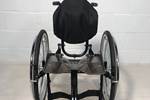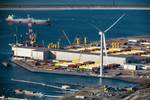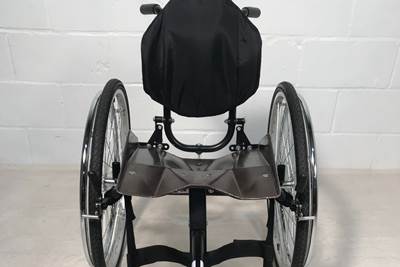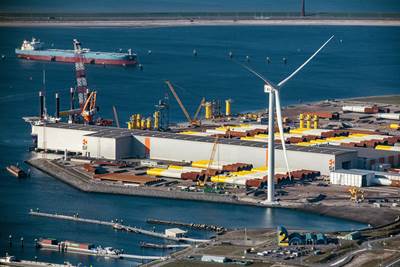NCC research supports new composite gripper solution for wind turbine installation
Compared to current steel clamping structures, which aid in turbine installation, the feasibility study established that composite grippers could cut cost points, installation time and reduce overall environmental impact.
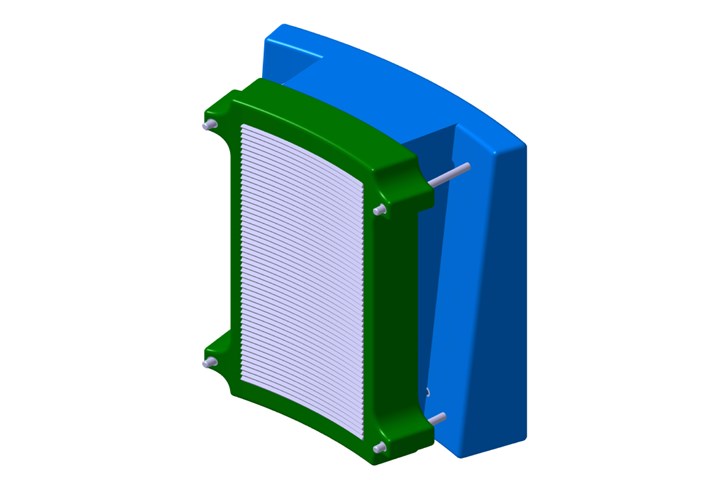
Photo Credit: Cedeco
A feasibility study conducted by the National Composites Centre (NCC, Bristol, U.K.) on behalf of Cedeco (Glasgow, Scotland) has shown that an innovative composite gripper solution could reduce the environmental impact, cost and time of installing offshore wind turbines.
Cedeco, an inventive engineering SME working in offshore oil and gas and renewables, applied funding from Offshore Wind Growth Partnership (OWG), a £100 million program supporting improvements in the U.K.’s productivity and competitiveness, to approach the NCC to investigate if composites could offer a sustainable, cost-effective, materials solution to manufacture a gripper that holds an offshore wind turbine leg in place.
According to the NCC, offshore wind turbine jackets currently sit with their legs inside tubular pile mountings in the seafloor, held in place by tonnes of grout that fills the gap between the jacket leg and the seabed pile. To aid installation, a steel clamping structure is used to hold the leg in place while the grout sets. The clamp usually remains and corrodes in place, creating seabed waste that remains for generations.
Through conceptual designs, cost modeling, material and process assessment and a life cycle assessment, engineers at the NCC established that using composite materials for the grippers could potentially decrease the targeted cost point by up to 50%, cut the installation time by up to 50 days on a 100-turbine farm and reduce the environmental impact of the turbine installation by up to 40%. Switching to a composite gripper could also remove unnecessary structures from the turbine leg and jacket and reduce the overall size of the wind turbine legs.
These factors, says the NCC, all combine to reduce the barriers currently faced when creating new wind farms. In improving the return on investment, they are a more attractive proposition for investors, and the reduced carbon footprint reduces the negative environmental impact of installing wind turbines further promoting them as an environmentally friendly power generator.
The project was funded by the Offshore Wind Growth Partnership’s (OWGP) first Grant Funding Competition, which is awarded to projects exploring advanced manufacturing solutions for offshore wind.
“As with any project, there is always some hesitation at the outset, but we are delighted with the results of the feasibility study,” says Jacqueline Morrison, commercial lead for Cedeco and IUK Women in Innovation award winner.
On working with the NCC team, Iain Steven notes that “the enthusiasm of the team was palpable with many of the outputs produced going beyond our expectations. The outcomes from the various work pages have helped cement some of the earlier work produced by Atkins while also underpinning much of the data submitted at this stage to DNV. The carbon reduction savings identified as part of the life cycle assessment are additional proof of the benefits the non-grouted connector can deliver.”
Cedeco is now applying for a IUK SMART grant with Atkins, the Offshore Renewable Energy Catapult (OREC, Glasgow, U.K.) and the University of Strathclyde to continue to develop the engineering and work towards scaled testing.
“As a micro-SME we know that our route to market will be through industry collaboration with the likes of the NCC and OWGP and working together with industry partners including a fabricator, installation contractor and wind developer,” Morrison continues. “With the help of OREC we created a commercial roadmap that sees the product coming to market mid-2025 and we are always on the lookout for new partners willing to travel with us on that journey. I'm glad we took those initial steps to apply for OWGP funding and I would encourage other companies, no matter what their size, to do the same. We're really looking forward to continuing our journey with the NCC and hopefully OWGP, too.”
Related Content
CIRA qualifies CMC structures for the reusable Space Rider
Italian team designs, builds and tests multiple large, complex thermal protection system structures made from patented ISiComp C/C-SiC ceramic matrix composites.
Read MoreTPI manufactures all-composite Kenworth SuperTruck 2 cab
Class 8 diesel truck, now with a 20% lighter cab, achieves 136% freight efficiency improvement.
Read MoreSyensqo composites demonstrate titanium replacement on Boeing MQ-25 Stingray
Validation of integrating Cycom 5250-4HT prepreg into the UAV’s exhaust nozzle structure underpins the material system’s use in other high-temperature aerospace applications.
Read MoreAl Seer Marine, Abu Dhabi Maritime unveil world’s largest 3D-printed boat
Holding the new Guinness World Record at 11.98 meters, the 3D-printed composite water taxi used a CEAD Flexbot to print two hulls in less than 12 days.
Read MoreRead Next
Natural fiber composite wheelchair seat design aims for sustainable mobility
The National Composites Centre and Motivation provide an easily manufactured, locally sourced mobility solution for disabled people in developing countries.
Read MoreVineyard Wind offshore project receives federal approval
U.S. commercial-scale offshore wind farm design to include GE Haliade-X wind turbines for 800 MW of wind energy development in Massachusetts.
Read MoreNext-gen fan blades: Hybrid twin RTM, printed sensors, laser shock disassembly
MORPHO project demonstrates blade with 20% faster RTM cure cycle, uses AI-based monitoring for improved maintenance/life cycle management and proves laser shock disassembly for recycling.
Read More
